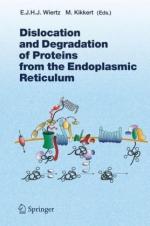|
This section contains 274 words (approx. 1 page at 300 words per page) |
A major component of the internal membrane system of eukaroytic cells (those with nuclei), the endoplasmic reticulum (or ER) is an enclosed network of membranous tubules, vesicles, and flattened cisternae (bags) extending throughout the cytoplasm of most cells. Comprising as much as 60% of all cellular membrane, the ER is generally divided into two major types. The rough endoplasmic reticulum (RER) is generally made up of extensive membrane sheets, the cytoplasmic surfaces of which are studded with ribosomes that carry out synthesis of proteins to be embedded in membranes, sequestered in endomembrane compartments or exported out of the cell. The smooth endoplasmic reticulum (SER) is composed of a branching network of membranous tubules. Enzymes on or within the SER are responsible for detoxifying poisonous chemicals, synthesizing lipids and steroids, and assembly of glycogen. The SER also is an major storage site for calcium, which is released to stimulate muscle contraction, enzyme action, membrane fusion, assembly of the cytoskeleton, and a host of other important reactions. Without these membrane systems, eukaryotic cells could not carry out their many different functions.
Both RER and SER are interconnected via direct contacts and mobile vesicles to other membranous components such as the Golgi apparatus, lysosomes, the nuclear membrane, and the plasma membrane. Coordinated cooperation between these compartments allow the numerous, complex activities of cellular metabolism to occur without interference between incompatible reactions. The intracellular traffic between these compartments is both rapid and complex and is regulated by an array of signal and docking proteins on various membrane surfaces. The motile force for this vesicular transport is provided by molecular motors attached to the cell cytoskeleton.
|
This section contains 274 words (approx. 1 page at 300 words per page) |


